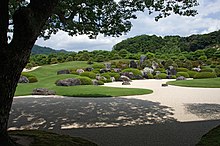Culture of Japan
The culture of Japan has evolved greatly over millennia, from the country's prehistoric Jōmon period to its contemporary hybrid culture, which combines influences from Asia, Europe and North America. The inhabitants of Japan experienced a long period of relative isolation from the outside world during the Tokugawa shogunate until the arrival of "The Black Ships" and the Meiji period.Japanese language
The Japanese language is spoken mainly in Japan but also in some Japanese emigrant communities around the world. It is an agglutinative language and the sound inventory of Japanese is relatively small but has a lexically distinct pitch-accent system. Early Japanese is known largely on the basis of its state in the 8th century, when the three major works of Old Japanese were compiled. The earliest attestation of the Japanese language is in a Chinese document from 252 A.D.
Japanese is written with a combination of three scripts: hiragana, derived from the Chinese cursive script, katakana, derived as a shorthand from Chinese characters, and kanji, imported from China. The Latin alphabet, rōmaji, is also often used in modern Japanese, especially for company names and logos, advertising, and when inputting Japanese into a computer. The Hindu-Arabic numerals are generally used for numbers, but traditional Sino-Japanese numeralsare also common.

Painting
Painting has been an art in Japan for a very long time: the brush is a traditional writing tool, and the extension of that to its use as an artist's tool was probably natural. Chinese papermaking was introduced to Japan around the 7th century by Damjing and several monks of Goguryeo,[1] later washi was developed from it. Native Japanese painting techniques are still in use today, as well as techniques adopted from continental Asia and from the West.Architecture
Japanese architecture has as long a history as any other aspect of Japanese culture. Originally heavily influenced by Chinese architecture, it also develops many differences and aspects which are indigenous to Japan. Examples of traditional architecture are seen at Temples, Shinto shrines and castles in Kyoto, andNara. Some of these buildings are constructed with traditional gardens, which are influenced from Zen ideas.
Some modern architects, such as Yoshio Taniguchi and Tadao Ando are known for their amalgamation of Japanese traditional and Western architectural influences.

Gardens
Garden architecture is as important as building architecture and very much influenced by the same historical and religious background. Although today, ink monochrome painting still is the art form most closely associated with Zen Buddhism. A primary design principle of a garden is the creation of a landscape based on, or at least greatly influenced by, the three-dimensional monochrome ink (sumi) landscape painting, sumi-e or suibokuga.
In Japan, the garden has the status of artwork.

Traditional clothing
Traditional Japanese clothing distinguishes Japan from all other countries around the world. The Japanese word kimono means "something one wears" and they are the traditional garments of Japan. Originally, the word kimono was used for all types of clothing, but eventually, it came to refer specifically to the full-length garment also known as the naga-gi, meaning "long-wear", that is still worn today on special occasions by women, men, and children. Kimono in this meaning plus all other items of traditional Japanese clothing is known collectively as wafuku which means "Japanese clothes" as opposed to yofuku (Western-style clothing). Kimonos come in a variety of colours, styles, and sizes. Men mainly wear darker or more muted colours, while women tend to wear brighter colors and pastels, and, especially for younger women, often with complicated abstract or floral patterns.CARS
And of course who will forget the CARS in JAPAN
especially PROSPER COMPANY LTD.,
one of the leading
JAPANESE USED CAR DEALER!!



